The very first issue of Esquire magazine, in Fall of 1933, included this full color illustration of a gentleman’s shoe wardrobe — the fall and winter version.
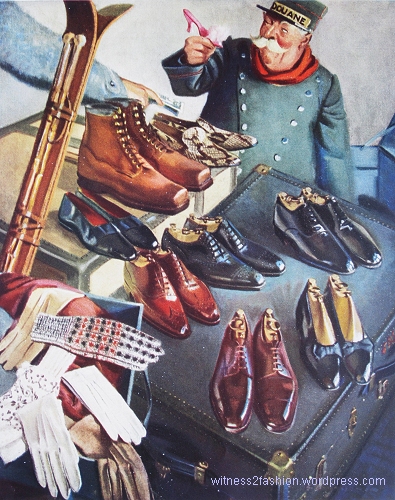
Man’s shoe and glove wardrobe, Esquire, Fall of 1933. Page 112.
For simplicity in identifying them, I have numbered the shoes in this closer view.
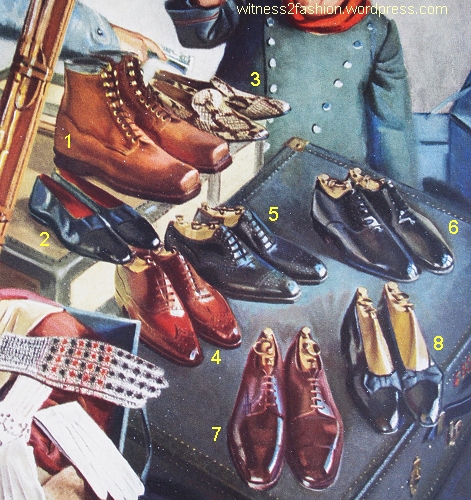
Shoes for men, Esquire. Fall, 1933.
- “A pair of Norwegian ski boots, of the square toed hooked kind worn by experienced ski jumpers”
- “Patent leather French pumps, designed … for being worn at home with dinner clothes… a lounge suit or dressing gown”
- “Hard soled slippers of python skin”
- “Brown wing tip shoe for informal town wear”
- “Black town shoe with straight perforated tip, for slightly more ‘dressed up’ usage”
- “The properly proportioned patent leather oxfords for evening wear.”
- ” Norwegian calf brogues with blucher front, in the dark shade of briar brown that polishes to a reddish near-black”
- “The correctly proportioned patent leather pumps for formal evening wear — that is, with the tailcoat.”
“The Norwegian calf brogues are really a sports and country item, but you can get by with them in town when your clothes are of the soft rough textured fabrics that have lately come into the town and business wardrobe.”
The brown wing tip and the black town shoe were the usual choices for business wear.
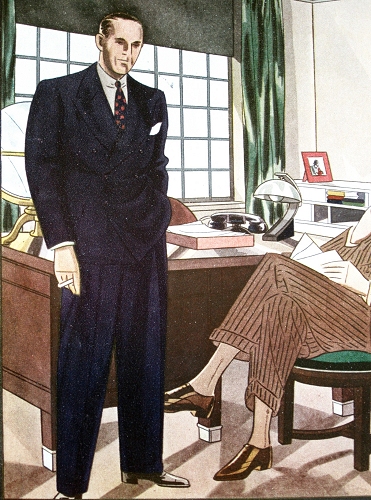
Left, a navy blue business suit, and right, a brown striped business suit. Esquire, March 1934, p. 106. The accompanying text tells us that the brown suit was much more informal than the navy one. Both are being worn with brown shoes.
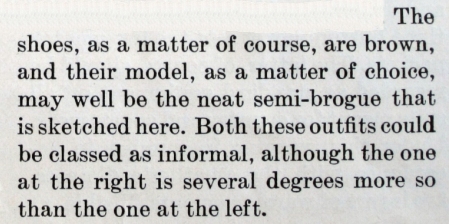
Shoes for summer were pictured in July of 1934, but the text was concerned with shoe care, polishes, brushes, etc.
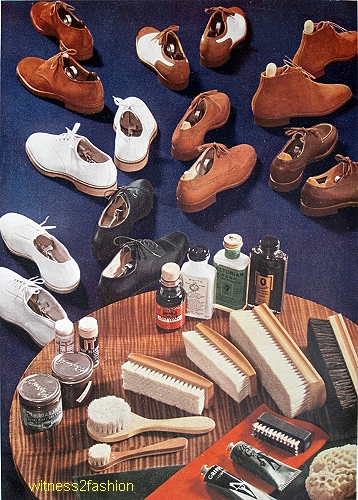
Shoes and shoe care products for men, Esquire, July 1934, page 124.
Here is a closer view of the shoes. Several pairs are buck or buckskin, including “white bucks.” Shoes with rubber soles can also be seen.

Summer shoes for men, Esquire, July 1934.
Most of these “summer” shoes are for wear in the country, at sporting events, or on vacation.
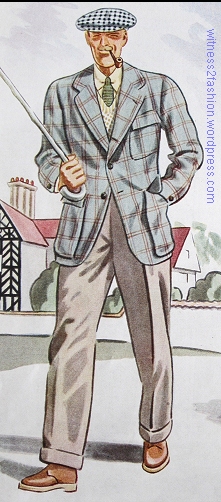
Country clothes with an “old English’ flavor. Esquire, Autumn 1933, p. 100. The shoes look like brown buck with a thick rubber sole.
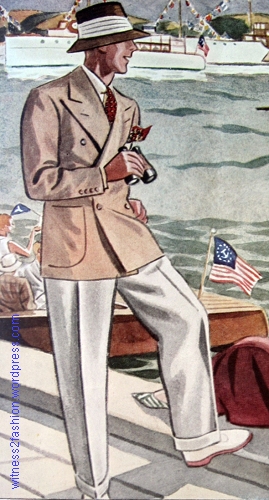
White buckskin shoes worn with light gray flannel slacks, resort wear for June 1934, Esquire, p. 121.
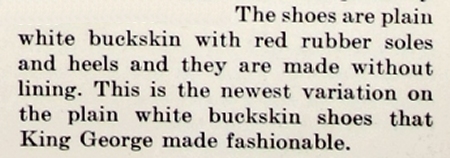
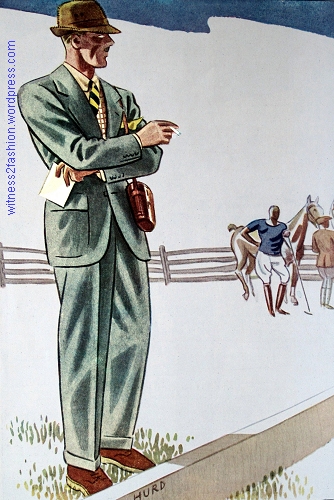
“Ahead of the crowd” spectator sport clothes, worn with brown buck shoes. Esquire, Sept. 1934, p. 116.
I was surprised by how similar these “tan waxhide” 2016 shoes from Samuel Hubbard look.
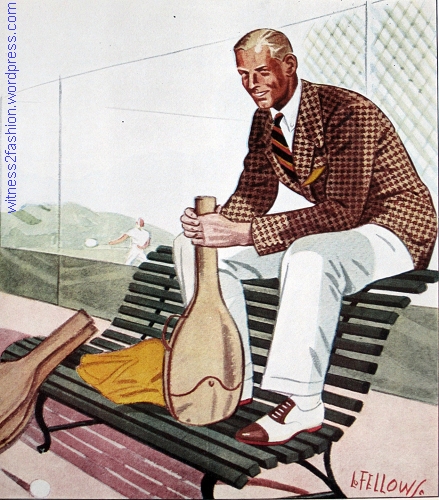
A cotton sport jacket worn for tennis or spectator sports. Rubber soled spectator shoes and white flannel trousers. Esquire, July 1934, p. 111.
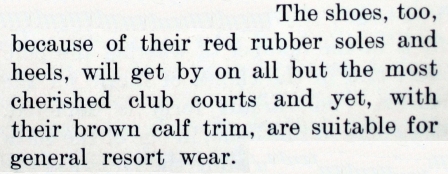
Two-toned shoes in black and white or brown and white were considered a bit too flashy in some circles. In England, they were sometimes called “co-respondent shoes;” when adultery was one of the only legal reasons for divorce, the “co-respondent” had to be named in the divorce court. Sometimes a gigolo was hired for this purpose — whether he actually wore two-toned shoes or not. Americans call them “Spectator shoes.” The Duke of Windsor wore them.
It’s a little surprising that Esquire was quite enthusiastic about brown shoes with gray or navy suits. Brown shoes could be polished every other day with a “deep red, like the famous Royal Navy Dressing,” to achieve a very dark red-brown, which was called “Oxblood” in the 1950s. This is an alternative to black with navy slacks.
Here, brown shoes are worn with a gray chalk striped suit, but the man wearing them is on vacation:

“The experienced traveler” is clearing customs in a chalk-striped suit worn with casual brown shoes. Esquire, July 1934.
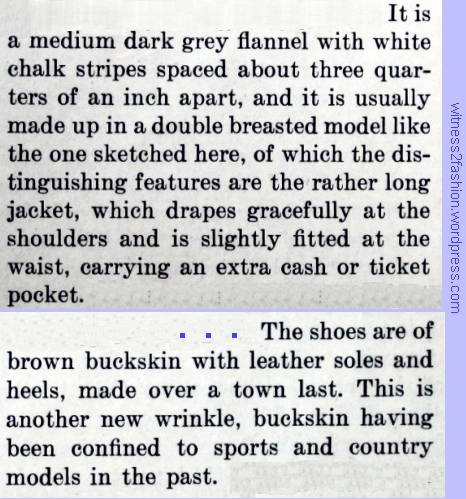
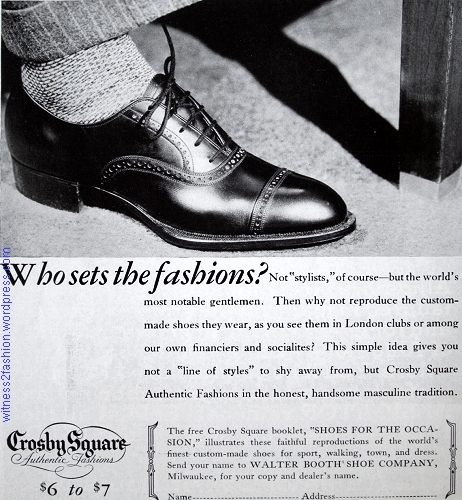
These Crosby Square shoes for men cost $6 to $7 in 1934. Esquire, Sept. 1934, p. 162.
This ad does not mention prices, but the Stetson Shoe company sold both formal dress men’s pumps and this brown wing tip brogue — for “college men.”
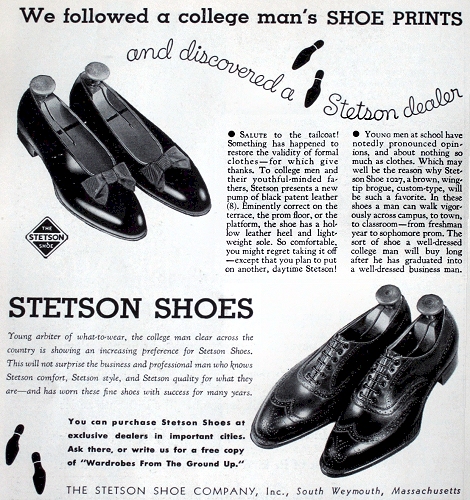
Ad for Stetson shoes for college men, Esquire, September 1934, p 160. Top, black leather pumps for formal evening wear; bottom, a brown, wing-tip brogue .
A “brogue” usually means that the shoe has decorative perforations. But the “Norwegian calf brogues” pictured at the top of this post seem to have much less perforated trim (if any) than the other “town shoes” in the same illustration. Maybe I will never master men’s shoe terminology….
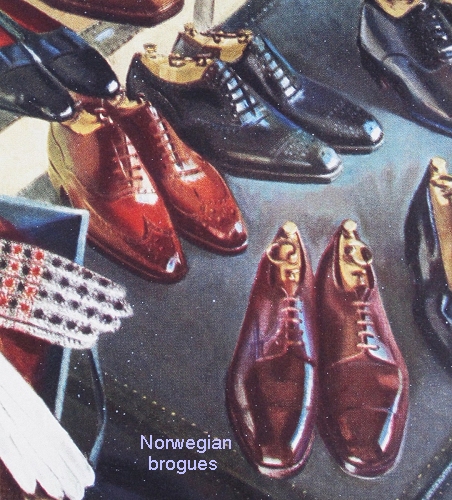
Traditional perforated “town” or business shoes, and “Norwegian calf brogues with blucher front.” Esquire, Autumn 1933.
If you want an explanation of what “blucher” means, the Gentleman’s Gazette explains in a video. Click here. (Hint: it does not mean that straight line across the toe cap! Look at the laces.)
